How To Use GA4 To Find Out Where Customers Come From
If you have a website or an app, you probably want to know how your customers find you online. This can help you optimize your marketing efforts and attract more quality traffic that converts into sales. One of the best tools for measuring your website or app traffic is Google Analytics 4 (GA4) .
Google Analytics can show you where your traffic comes from (source), how they get to your website or app (medium), and what specific marketing campaign drives them there (campaign). You can use this information to improve your marketing strategy and increase your conversions.
In this blog post, we will guide you through the steps to access this information in GA4, the latest version of Google Analytics.
How to Find the Traffic Acquisition Report
The ‘Traffic acquisition’ report shows you where your new and returning customers come from. You can find this report under Reports > Acquisition in GA4. However, depending on your GA4 configuration, it might be in a different section.
This report uses session-based dimensions. A session is the period from when a customer visits your website or app to when they leave it. For example, if someone visits your website, adds something to their cart, and then leaves your website, that is one session. If they come back the next day and buy something, that is another session.
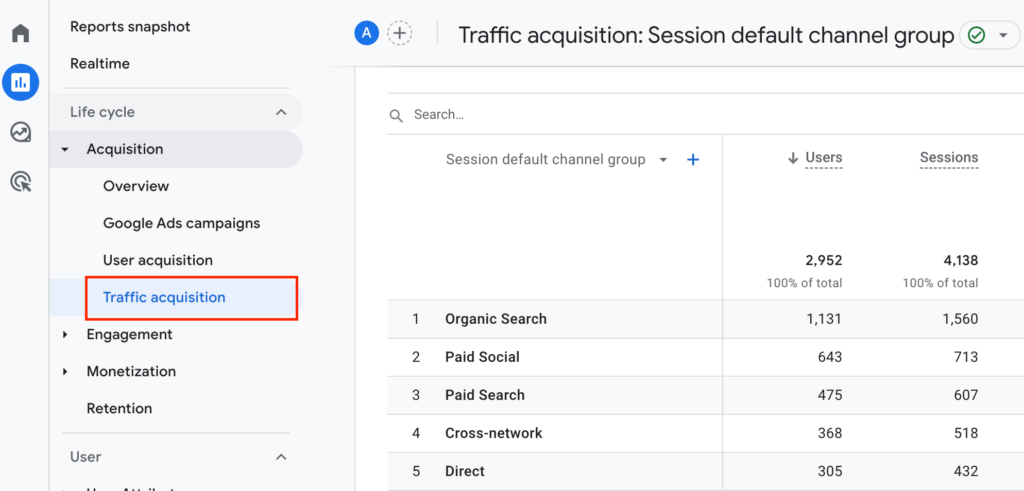
By default, the dimension on the ‘Traffic acquisition’ report is the ‘Session default channel group’. Channels are predefined categories of traffic sources that give you a high-level overview of where your website visitors come from. Some examples of channels are ‘Direct’, ‘Organic Search’, ‘Paid Social’, ‘Organic Social’, and ‘Email’. You can learn more about the channel definitions here [GA4] Default channel group.
If you want to see more details about the traffic source (e.g., ‘google’, ‘(direct)’, ‘gmail’, etc.), medium (e.g., ‘organic’, ‘cpc’, ‘affiliate’, etc.) and campaign, you can select the dimensions: ‘Session source’, ‘Session medium’ and ‘Session campaign’ accordingly.
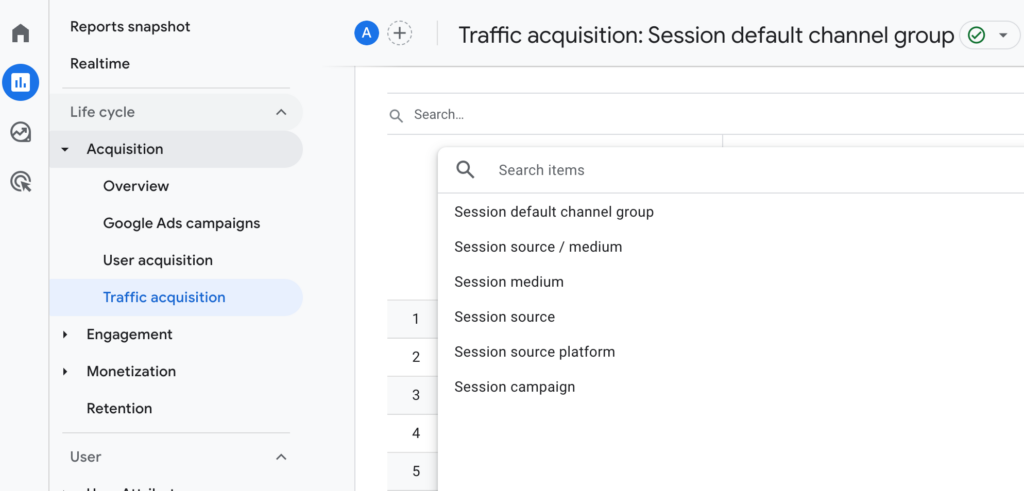
In case you see a lot of ‘Unassigned’ values on this report, it means that there is an issue with your GA4 setup that needs to be fixed. Please reach out to us for assistance.
How to Find the User Acquisition Report
Unlike the ‘Traffic acquisition’ report, the ‘User acquisition’ report only shows you where new customers come from. Unless you have customised your GA4 settings, you can also find this report under Reports > Acquisition.
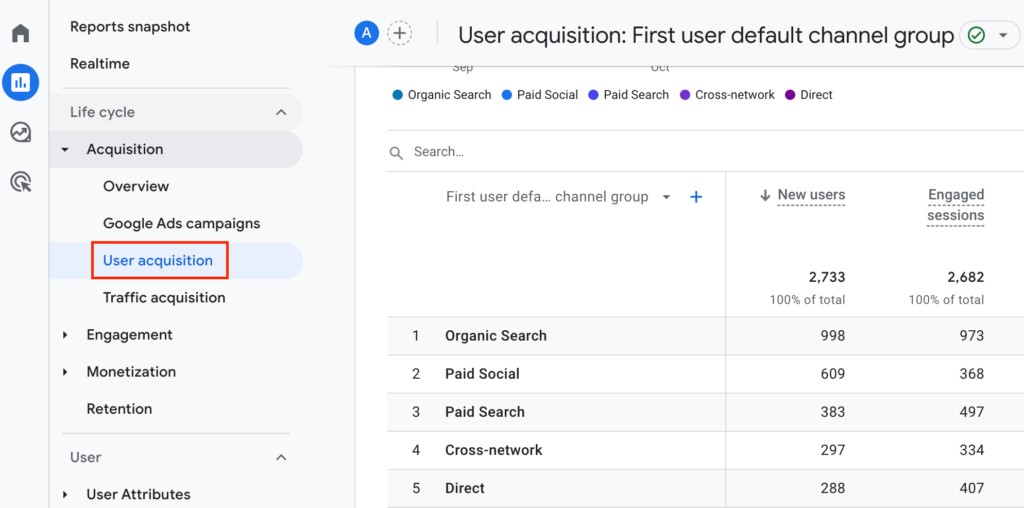
This report uses dimensions that include the ‘First user’ prefix to indicate how the customer was acquired.
The default dimension on the ‘User acquisition’ report is the ‘First user default channel group’. This is similar to the channel dimension on the ‘Traffic acquisition’ report, but it only shows the first channel that brought the customer to your website or app.
You can find more details about the source, medium and campaign that acquired the customer by selecting the dimensions: ‘First user source’, ‘First user medium’ and ‘First user campaign’.
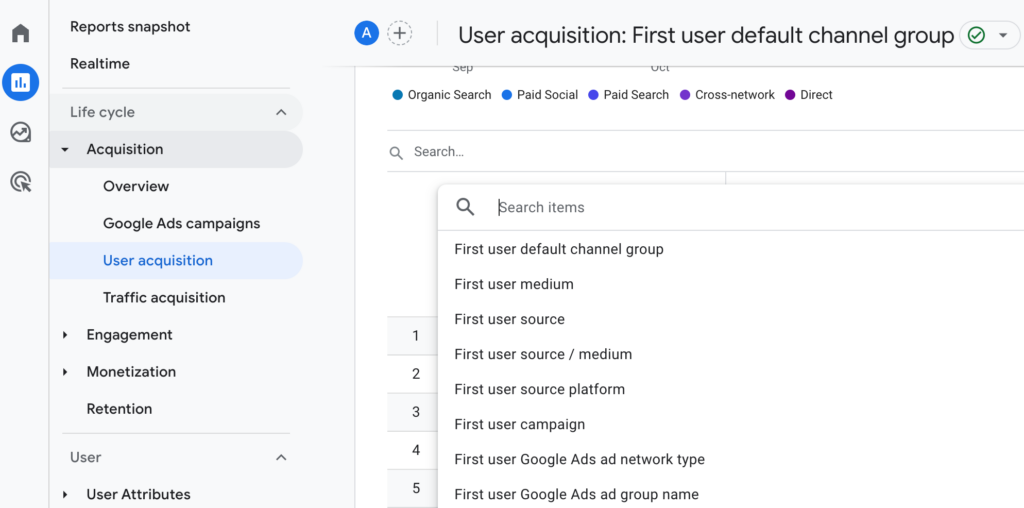
If you want to know more about other ‘First user’ dimensions, you can check out this [GA4] User acquisition report .
How to Find the Advertising Performance Report
The ‘Advertising Performance’ report shows you which source, medium and campaign is credited for a conversion on your website or app. Any customer action that is important for your business success is called a conversion. Some examples of conversions are a customer purchase online or a newsletter subscription.
You can find this report under Advertising > Performance in GA4. Note: In GA4, you can choose which events measure the valuable customer interactions and mark them as conversion events.
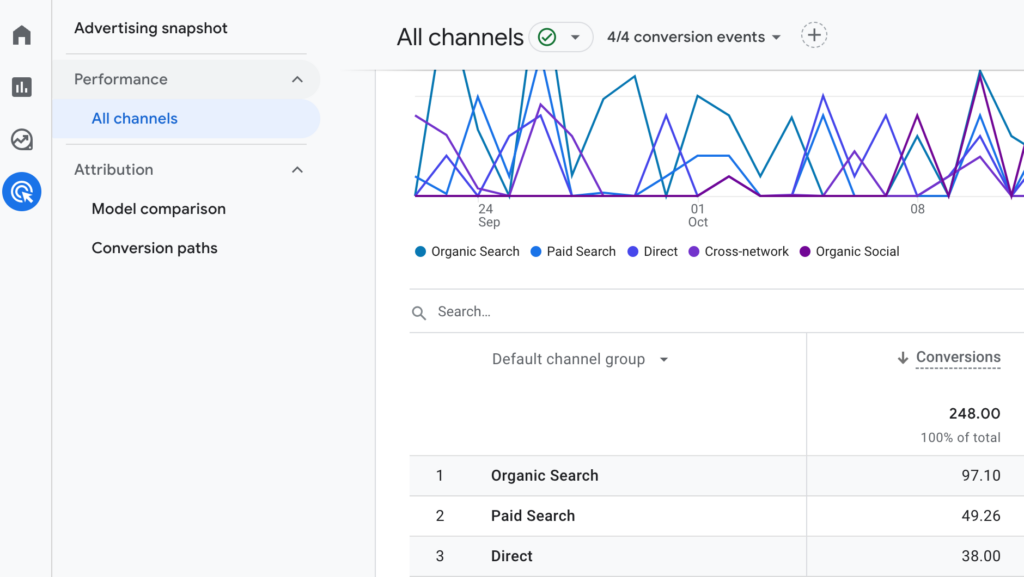
When you open the report, you will see the ‘Default Channel Group’ dimension. This dimension which gives you a high-level overview of the channels that bring conversions to your website or app. If you want to see more details about the sources, mediums, and campaigns of your conversions, you can select the following dimensions:
- ‘Source’: The origin of the traffic
- ‘Medium’: The method of delivery of the traffic
- ‘Campaign’: The marketing initiative that drives the traffic
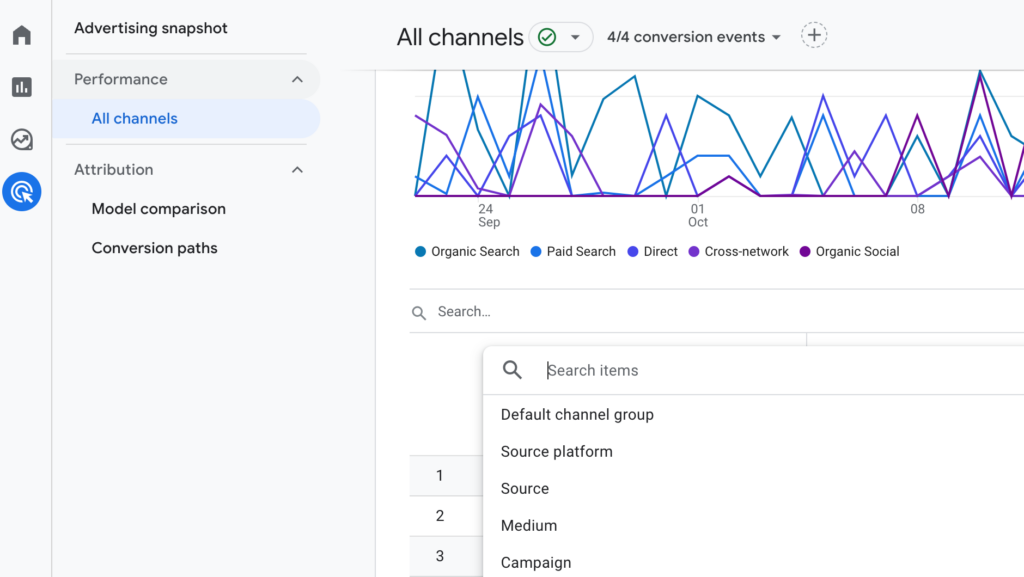
How to Understand Attribution Models
Attribution models are the rules or algorithms that determine how credit for conversions is assigned to different touchpoints on the customer’s journey. For example, if someone clicks on your ad, then visits your website directly, and then makes a purchase, how much credit should each touchpoint get?
In GA4, there are two main types of attribution models that are used in different reports:
Paid and Organic Last Click
Both the ‘User acquisition’ and ‘Traffic acquisition’ reports, in GA4, use the ‘Paid and Organic channels last click’ attribution model. This model is also known as ‘Last non-direct click’, and it assigns 100% of the credit for a conversion to the last channel that the customer clicked through (or viewed for YouTube) before converting. For example:
- Display > Social > Paid Search > Organic Search – 100% credit given to Organic Search
- Display > Social > Paid Search > Email – 100% credit given to Email
- Display > Social > Paid Search > Direct – 100% credit given to Paid Search
Direct visits are not counted unless they are the only way the customer reached your site.
Data-driven Attribution
The ‘Performance’ report under ‘Advertising’ uses the data-driven attribution model. This model uses machine learning algorithms to analyse historical data and assign credit to different channels based on their impact on conversions. The channels that have a higher impact on conversions receive a higher credit weight, but every channel on the journey gets some credit. This is why you will see decimal values when analysing this report.
You can learn more about attribution models and how they affect your reports here [GA4] About attribution and attribution modeling .
Conclusion
Google Analytics is a powerful tool that can help you measure your website or app traffic and marketing performance. You can use these three reports and dimensions to get a high-level or granular view of how your customers get to your website or app, and what campaigns drive them to convert. You can also use different attribution models to understand how credit for conversions is assigned to different touchpoints on the customer’s journey. By using this information, you can optimize your marketing budget and strategy to achieve your business goals.
We hope this blog post was helpful for you. If you have any questions or need any assistance with Google Analytics, please feel free to Contact us . We are happy to help!

I am the Martech Ninjas founder, covering all things digital analytics. With 10+ years’ worth of experience in marketing and analytics, and having the privilege of working across 4 different countries, I have seen it all! Something I have always seen in the world of digital analytics is how poor data quality and the lack of standardisation is hurting businesses in their data-driven decisions to achieve growth. When I’m not immersed in the world of digital analytics, I enjoy working out and try new cuisines – yes, in this order!
Most Viewed Blog Post
Why manual UTMs from Google Ads do not show up in GA4?
Why GA4 Landing Page Report Shows “Not Set”
How To Fix the GA4 Landing Page Report Not Aligned with GA3
Get a Free
GA4 Guide
Enter your name and email address. We'll send you a free copy of our GA4 guide, which highlights the importance of migrating to GA4 and its amazing benefits for your business.

